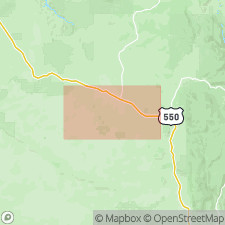
- Usage in publication:
-
- Escavada Member
- Modifications:
-
- Named
- Dominant lithology:
-
- Sandstone
- Mudstone
- Siltstone
- AAPG geologic province:
-
- San Juan basin
Summary:
Here named as uppermost member of early and late Paleocene Nacimiento Formation (revised). Named for Escavada Wash, where type section and extensive exposures are located at SE1/4 SW1/4 SW1/4 sec 27, T23N, R7W, Lybrook 7.5-min quad, south of Kutz Canyon in southern San Juan basin, Sandoval Co, northwestern NM. See also the Nacimiento's composite section and well log correlation (Figs. 5, 9, and 10). Extends to West Flank Torreon Wash, East Flank Torreon Wash, and to Mesa de Cuba (all in Sandoval Co), northwestern NM. Outcrop habit characterized by thin, indurated ledges largely responsible for steep slopes and resistant benches. At type consists of 58% sandstone, 31% mudstone, 4% siltstone, and 7% silcrete. Sandstones are typically gray and trough cross-bedded; mudstones typically dark gray and brown, bentonitic, and, in some beds, very carbonaceous; silcretes are gray or white, weather brown and blocky, and form the thin (up to 0.5 m) indurated ledges. At type, total thickness is 79.7 m; ranges from 19.2 to 88 m. Apparently conformably overlies early Paleocene Ojo Encino Member (new), the contact always placed at base of first persistent sandstone or silcrete bed above typically variegated mudstone of the Ojo Encino. Unconformably underlies dark yellowish orange sandstone belonging to the [early Eocene] Cuba Mesa Member of San Jose Formation. Correlation determined by reading subsurface electric-log signatures in wells and by surface measured sections. Age is early and late Paleocene (Danian and Thanetian), based on magnetostratigraphy. No age-diagnostic fossils are known from the Escavada. Report includes geologic sketch map, correlation charts, field notes, composite sections, well logs, and measured sections.
Source: GNU records (USGS DDS-6; Denver GNULEX).
For more information, please contact Nancy Stamm, Geologic Names Committee Secretary.
Asterisk (*) indicates published by U.S. Geological Survey authors.
"No current usage" (†) implies that a name has been abandoned or has fallen into disuse. Former usage and, if known, replacement name given in parentheses ( ).
Slash (/) indicates name conflicts with nomenclatural guidelines (CSN, 1933; ACSN, 1961, 1970; NACSN, 1983, 2005, 2021). May be explained within brackets ([ ]).

